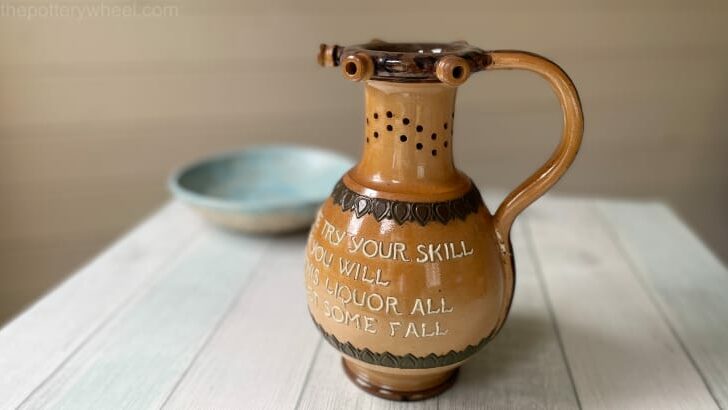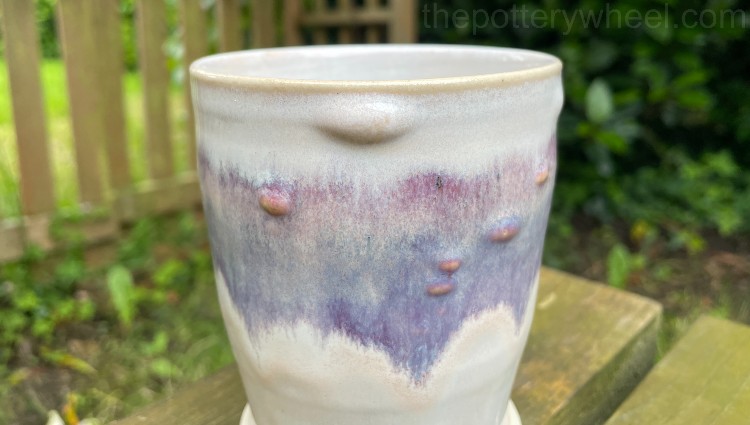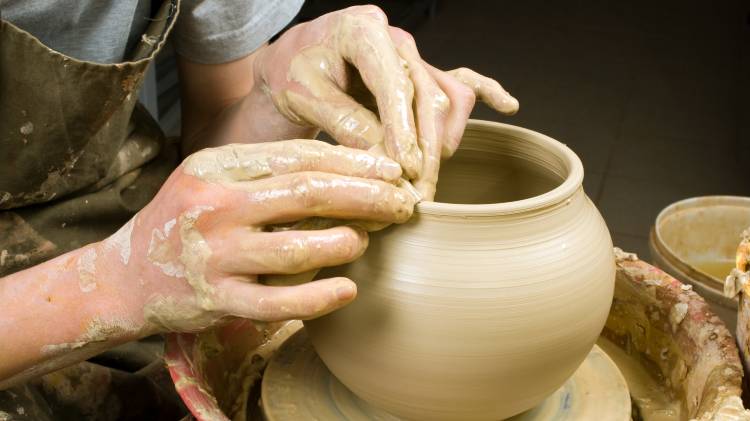Puzzle jugs are clever drinking vessels that have been made to confuse and entertain drinkers and party guests for centuries. These charming curiosities have an interesting history and still hold a fascination today.
In this article, we will look at the following:
- How puzzle jugs work
- The production process
- Different styles of puzzle jugs
- The history of the puzzle jug
- Related vessels
- Where you can buy puzzle jugs today
What are Puzzle Jugs?
Puzzle jugs are specially designed vessels that were designed to keep drinkers guessing. The idea was that they had to figure out how to get the liquid in the vessel out of the jug without spilling it on themselves.
This was a challenge because the puzzle jug had holes around the neck of the vessel. Sometimes these holes were just circular perforations. And other times the holes were stylish carvings that looked like lacework around the neck.
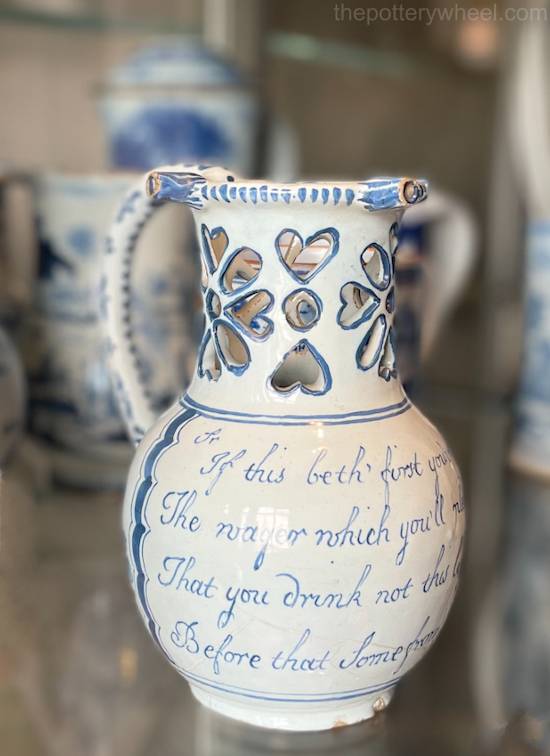
Maker unknown, ca. 1750-1760. On display at the V&A Museum
If the drinker tried to drink from the jug or pour it, the wine, beer, or water would spill onto them from the holes around the neck.
The game that the puzzle jug presented was to challenge the drinker to find a way to get the liquid out without spilling it.
In addition to having holes around the neck, puzzle jugs usually had a number of spouts positioned on the top edge of the jug. It wasn’t always immediately clear that these openings were spouts.
And once the drinker had figured out that these openings were spouts to drink from, they had to figure out which spout to use.
Sometimes there would be a verse written around the body of the vessel taunting the drinker and challenging them to figure out the puzzle.
A typical challenge would read something like this…
“Within this jug, there is good liquor, ‘Tis fit for Parson or for Vicar, But how to drink and not to spill, Will try the utmost of your skill”
How do Puzzle Jugs Work?
The mystery of the puzzle jug lay in a couple of secret tubes hidden in the jug itself. The rim of the jug was often a bit fatter than the neck. And the reason for this was that the rim of the jug was in fact a hollow tube.
The spouts positioned around the rim were access points to the tube. In turn, the hollow rim was connected to another tube. This second tube actually ran down the inside of the jug handle.
The tube in the handle was connected to the rim and had an exit point at the base of the jug.
Here is a cross-section of how the puzzle jug worked, so you can visualize it clearly.
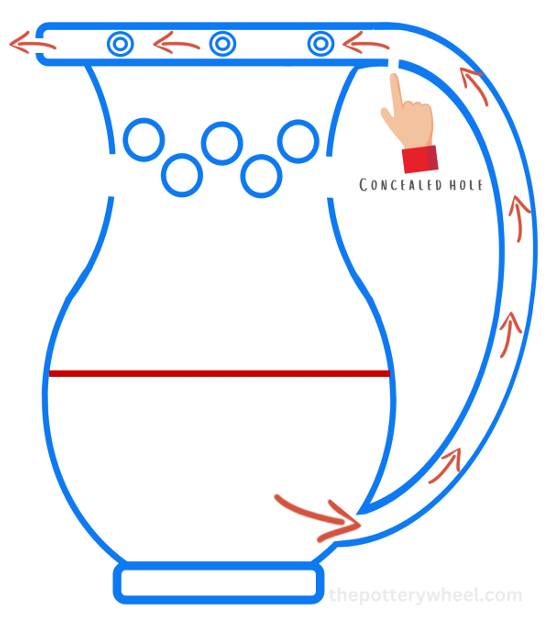
In order to drink the liquid in the jug, the drinker had to suck on one of the spouts on the rim. This would draw the liquid up from the opening at the base of the hollow handle. The liquid would then pass up the handle, around the rim, and into the patient drinker’s mouth.
The Drinkers Challenge
In order to get the jug to work, the drinker had a couple of other challenges to figure out. With some puzzle jugs only one of the spouts on the rim was functional and the others were blocked dummy spouts. So, the drinker had to work out which one was functioning.
On other puzzle jugs, each of the spouts worked and had a hole in them that led to the tube in the ring. In this case, the drinker had to cover up all but one of the spouts. By covering the extra spouts they sealed the tube system in the jug and created a vacuum.
Once the extra spouts had been covered, the drinker could suck on the remaining spout and draw liquid up from the bottom of the jug. It’s for this reason that puzzle jugs are sometimes called ‘Suction Jugs’.
The Secret Hole
In addition to the multiple spouts, many puzzle jugs also had another secret hole that broke the seal on the vacuum. This secret hole meant that even if the drinker covered up the extra spouts, there was no suction in the tubes and they still couldn’t drink the wine.
Often the secret hole was positioned in the handle of the jug. It was placed on the underside of the top part of the jug. To seal the tubes in the rim and the handle the drinker had to put their thumb over the secret hole.
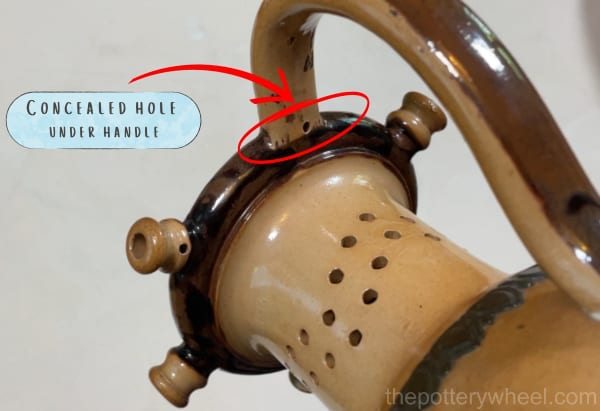
Once this hole was covered, they could then suck on the spout and finally drink the wine without spilling it. In addition to the secret hole under the handle, there were sometimes other small holes under spouts that needed to be covered too.
How are Puzzle Jugs Made?
Puzzle jugs were often made on the potter’s wheel. The potter throws the jug so that the top edge of the vessel has a hollow rim.
Once the clay has firmed up and become leather-hard, the spouts and hollow handle can be attached to the jug.
Holes or decorative perforations are then carved into the neck of the jug. The jug is then fired in a kiln so that the clay becomes ceramic bisque ware.
When the clay is ceramic bisque, it can be dipped in liquid glaze and refired to create a glossy glaze coating. The potter would prevent liquid glaze from filling up the tubes by plugging the openings to the spouts when it was being dipped in glaze.
Different Styles of Puzzle Jugs
A lot of puzzle jugs were made out of earthenware clay. They were decorated using a range of techniques. One popular technique was tin glazing. Tin glazing, as the name suggests is the use of glaze that contains tin.
Tin-Glazed Puzzle Jugs
The tin in the glaze creates a nice opaque white covering on the jug. Once the glaze had been dipped in glaze, decorations were painted onto the glaze surface using colored oxides. Sometimes just one colored oxide was used. Usually, this was cobalt oxide which turns blue when it’s fired. This is called monochrome tin glaze.
But sometimes a range of colored oxides were used to make polychrome tin-glazed puzzle jugs.
Tin glazing was common with puzzle jugs made by the Dutch and English Delftware pottery factories in the 17th century. You can read more about Delftware here.
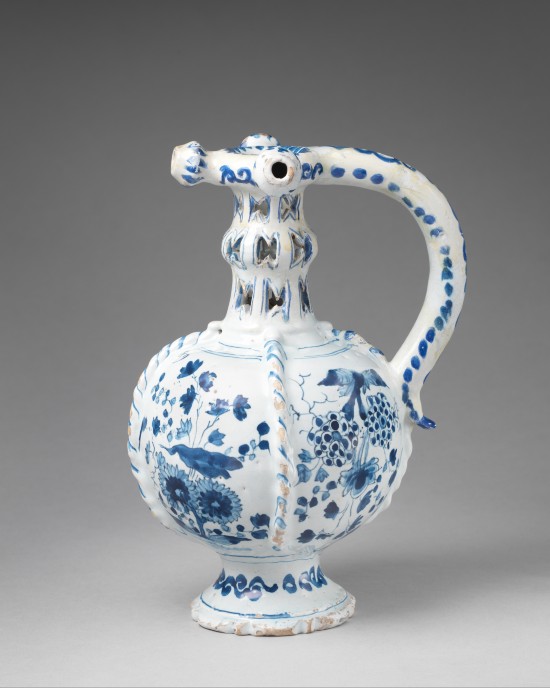
Public domain, courtesy of The Met Museum
Agateware Puzzle Jugs
Agateware puzzle jugs were also popular. This is when two or more different colored clays are used in the same vessel. When the different colored clays blend together on the potter’s wheel, it produces streaks of color that swirl around the jug.
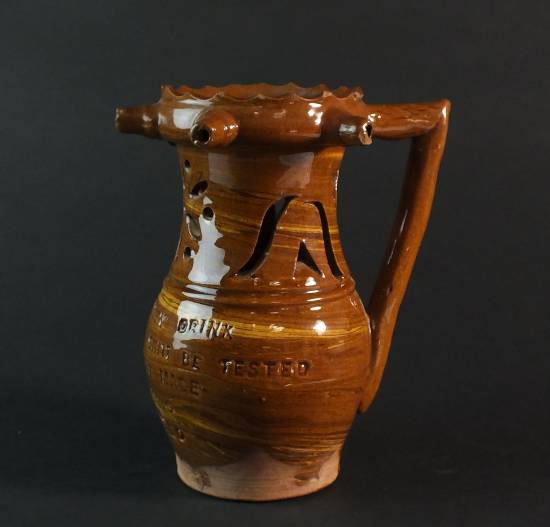
Image courtesy of Halls Fine Art Auctions
Slipware Puzzle Jugs
Another popular style of decorating puzzle jugs was the use of clay slip. Clay slip is liquid clay that is made by suspending clay particles in water. Pottery decorated in this way is known as slipware.
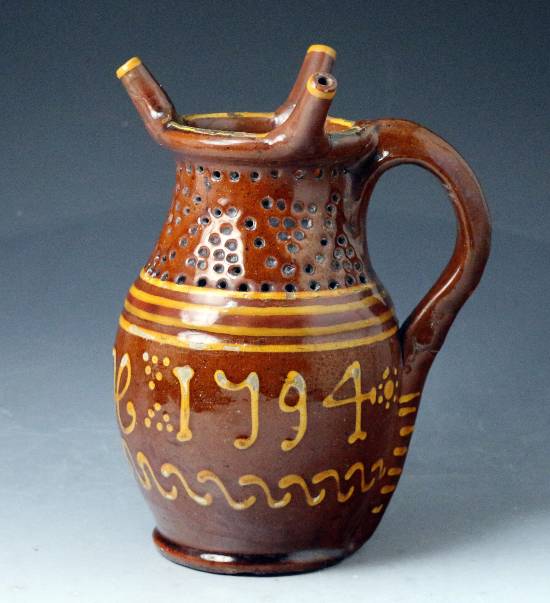
Image courtesy of John Howard Antique Pottery
Salt-Glaze Stoneware Puzzle Jugs
Puzzle jugs were also made out of stoneware and porcelain. Often the stoneware puzzle jugs were salt glazed.
Porcelain Puzzle Jugs
A lot of puzzle jugs were made in China around the turn of the 18th Century. These were usually made out of hard past porcelain. They were often produced in China to be sold in Europe.
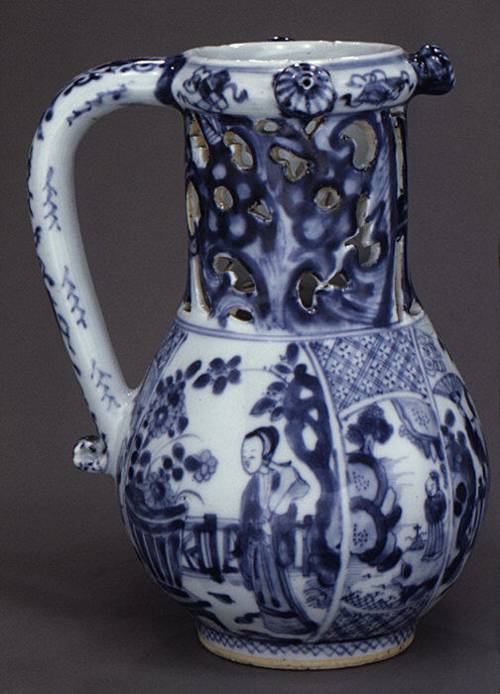
Public domain, courtesy of The Met Museum
The History of the Puzzle Jug
Historians, archaeologists, museum curators, and potters have different thoughts on the history of the puzzle jug.
Some accounts state that puzzle jugs date back to the middle-ages. Other accounts put their invention at a later date, around the 17th century.
Medieval Puzzle Jugs
Some of the earliest pieces of pottery that are described as puzzle jugs were created in the middle ages.
One example of this is referred to as the Exeter Puzzle Jug. Exeter is in England, although this particular jug was made in Saintonge in France. The jug is dated back to between 1300AD and it is located at the Royal Albert Memorial Museum in Exeter.
The Exeter Jug has an elaborate design decorated with the figures of musicians on the outside. On the inside of the jug are a couple of naked bishops. The jug is an early parody of the medieval church.
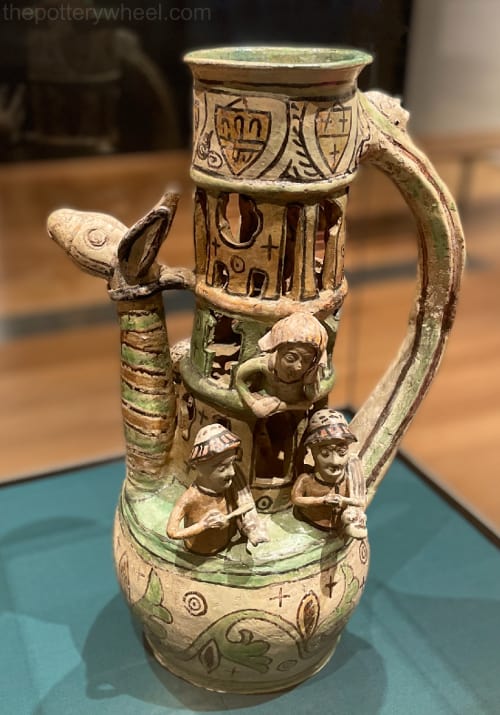
On display at the Royal Albert Memorial Museum in Exeter, UK
The Exeter Jug is categorized as being a puzzle jug because there are two chambers where liquid can be held. These two chambers are connected by a hollow tube in the handle of the jug.
However, some researchers argue that technically, a vessel like the Exeter Jug isn’t actually a puzzle jug. The jug does have an elaborate design, and a hidden tube in the handle.
Nevertheless, it’s not designed to trick the drinker. There are no spouts on the top rim, and the user doesn’t have to figure out how to get the contents out of the jug without spilling them.
Puzzle Jugs over the Centuries
Puzzle jugs using tubes and concealed holes were made from the 17th century onwards in Italy, France, Germany, the Netherlands, Britain, and other countries. However, they became particularly popular in the 18th and 19th centuries.
Here is an example of a puzzle jug made around 1890. It is an elaborate Majolica Palissy puzzle jug with features that remind me of the grotesque tradition.
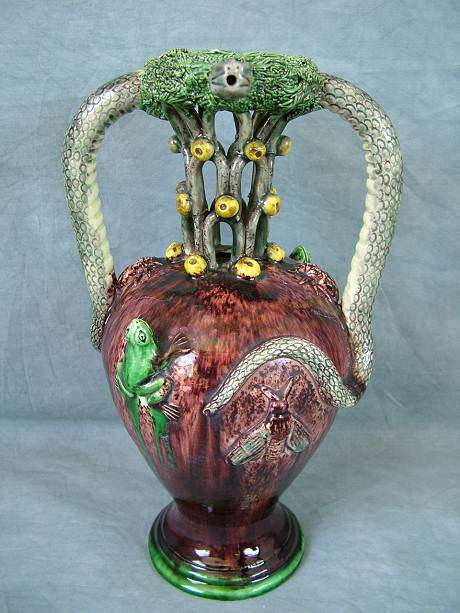
Image courtesy of Madelena Antiques & Collectables
The elaborate design of the Palissy ware jug contrasts with a very early jug found in 1895 in Oxford, England. It is dated back to AD1300 and is on display at the Ashmolean Museum of Oxford
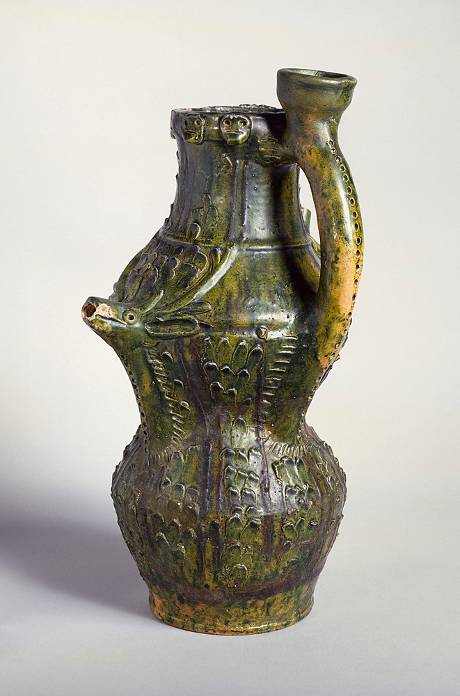
Image courtesy of The Ashmolean Museum, Oxford
This jug has a hollow handle, and a drinking spout midway up its side. If the drinker tipped the jug and drank from the rim, the liquid would pour on him or her from the spout. However, it doesn’t have spouts around the rim or a secret hole in the handle. But it is considered an earlier version of a puzzle jug.
Similar Vessels to Puzzle Jugs
There are other types of vessels that share some similarities with the puzzle jug. Here are some examples:
The Puzzle Mug
Puzzle jugs had a bulbous bottom and a jug-like profile. However, puzzle mugs, have also been made using the same internal tubes and holes to confuse drinkers.
The difference with puzzle mugs is that often they didn’t have spouts around the top. Instead, they had a series of holes around the rim.
Muddy Mountain Pottery makes lovely puzzle mugs today. You can check them out here.
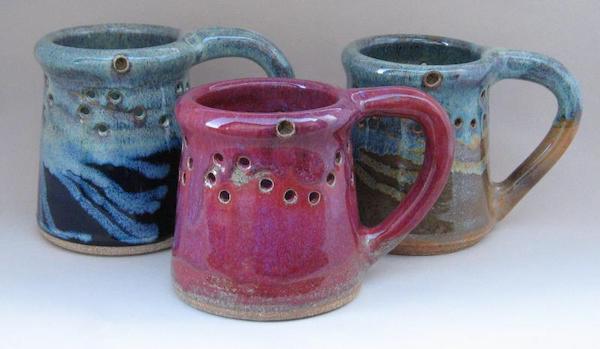
The Posset Pot
A posset pot had a low-lying spout that entered the vessel at the base. The idea was that the liquid could be drunk from the bottom of the pot.
This was helpful if the surface of the liquid had froth on it that the drinker wanted to avoid consuming. The difference between a posset pot and a puzzle jug is that the posset pot was not meant to be a game.
Here is an example of a 17th-century English posset pot. It is considered chinoiserie, which is a style that copies Chinese decoration.
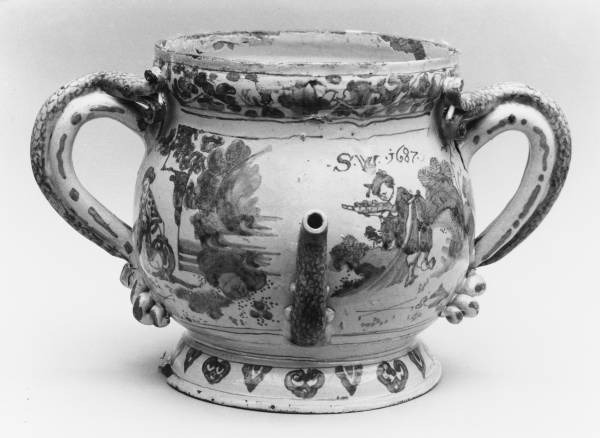
Public domain courtesy of The Met Museum
Fuddling Cups
A fuddling cup is made up of three or four separate drinking cups. These are usually thrown on a potter’s wheel. The cups are then connected together using tubes. These tubes are hollow, so when wine or beer is poured into one cup the other cups fill up too.
The idea was that the drinker had to drink out of the cups in a particular order to avoid spilling the drink on themselves.
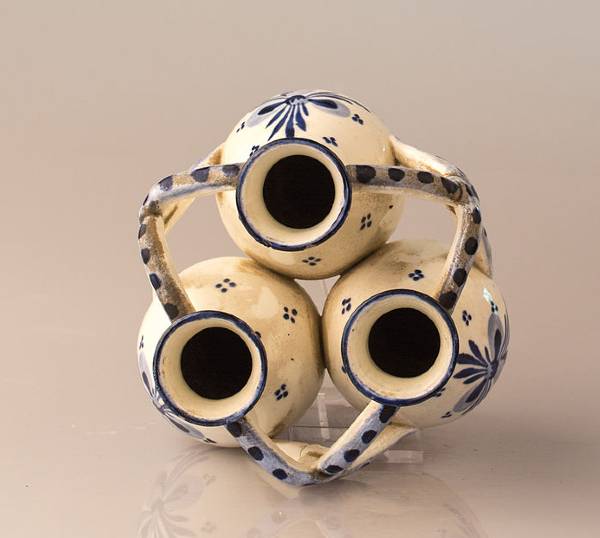
The French Gargoulette
The French Gargoulette has a spout on one side to be filled with liquid. The other spout is designed to be drunk from. They were designed to keep drinks cool in the hot weather.
There is no element of trickery in a gargoulette, but there is something about the overall look and feel that reminds me of a puzzle jug.
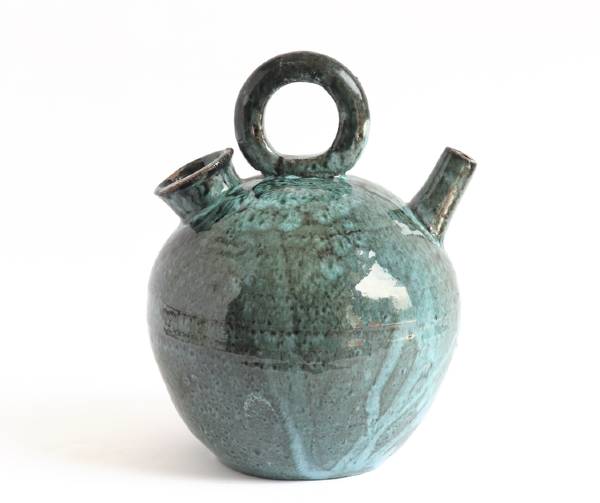
Where to Buy Puzzle Jugs Today
Potters still like making puzzle jugs today. These days there are lots of other ways that drinkers entertain themselves and the puzzle jug has taken a back seat. Nevertheless, the puzzle jug retains its old charm and curiosity.
Many pre-loved antique and vintage examples can be bought on platforms like eBay and Etsy. And puzzle jugs are found for sale in auction houses too.
Having said that there are still potters today making puzzle jugs. As mentioned above, Muddy Mountain Pottery makes and sells lovely puzzle mugs. And Potted History sells their own beautiful puzzle jugs too.
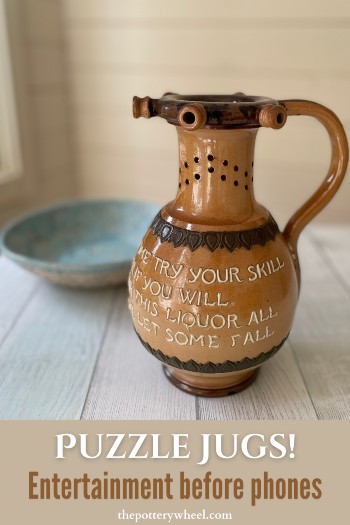
Final Thoughts
I can’t help but think that life was better when we were being confused by puzzle jugs in the local tavern rather than staring at our phones! Puzzle jugs are a feat of design and imagination. After all, what’s more fun than watching someone we care about look confused and foolish?

